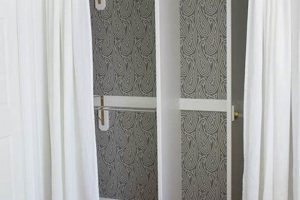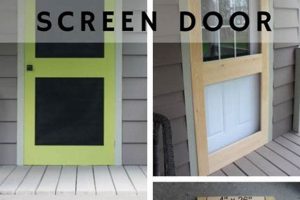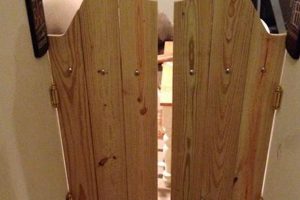A do-it-yourself project focused on creating a barrier to minimize unwanted airflow beneath doors is a common home improvement endeavor. This undertaking typically involves constructing or assembling a device, often from readily available materials, designed to block gaps between the bottom of a door and the floor. An example might include sewing a fabric tube filled with rice or sand, or repurposing foam or rubber materials to create a seal.
The significance of creating a barrier against airflow stems from potential energy savings and enhanced comfort within a building. By reducing drafts, heating and cooling systems operate more efficiently, leading to lower energy bills. Historically, methods of preventing drafts have evolved from simple weatherstripping to more elaborate solutions as awareness of energy conservation increased. This practice reduces environmental impact and creates a more comfortable living space.
Further discussion will delve into various approaches to this project, considering factors such as material selection, construction techniques, and aesthetic integration. The effectiveness and longevity of different designs will also be examined, providing insights into optimizing the performance of these homemade solutions.
Construction and Implementation Guidance
The following guidelines are intended to maximize the effectiveness and longevity of homemade airflow barriers designed for use at door bottoms. Attention to detail during construction and installation is crucial for optimal performance.
Tip 1: Material Selection. Choose durable, weather-resistant materials appropriate for the intended environment. Fabrics should be tightly woven to prevent leakage of fill. Rigid materials should be resistant to moisture and deformation.
Tip 2: Accurate Measurement. Precisely measure the width of the door and the gap beneath it. Oversized barriers may impede door movement, while undersized barriers will fail to adequately block airflow.
Tip 3: Secure Attachment. If attaching the barrier to the door, utilize fasteners appropriate for both the barrier material and the door surface. Ensure a secure, flush connection to minimize gaps.
Tip 4: Adequate Weighting. For unattached barriers, sufficient weight is necessary to maintain consistent contact with the floor surface. Sand, rice, or similar dense materials are suitable weighting agents.
Tip 5: Seam Reinforcement. Reinforce all seams and closures with durable stitching or adhesive to prevent tearing or separation over time. This is particularly important for fabric-based solutions.
Tip 6: Floor Surface Compatibility. Consider the floor surface when selecting materials. Abrasive materials may damage delicate flooring, while smooth materials may slide excessively on hard surfaces. Consider using non-slip underlays.
Tip 7: Regular Maintenance. Periodically inspect the barrier for wear and tear. Repair or replace damaged components promptly to maintain effectiveness.
These tips represent crucial elements in creating effective barriers against unwanted airflow beneath doors. Implementing these strategies will improve overall energy efficiency and interior comfort.
The subsequent sections will offer additional information on advanced techniques and troubleshooting common challenges encountered during construction and usage.
1. Material Selection
Material selection forms a foundational element in the effectiveness and longevity of any do-it-yourself door airflow barrier. The properties of the chosen materials directly influence the barrier’s ability to impede airflow, resist wear and tear, and maintain its structural integrity over time. For instance, using lightweight, permeable fabric will result in a barrier that is easily displaced by drafts and offers minimal insulation. Conversely, selecting a dense, insulating material like closed-cell foam or heavy fabric will provide a more robust and effective barrier. The interaction between the chosen material and the surrounding environment, including humidity levels and floor surface type, must also be considered.
The selection process should consider both the exterior casing and the filling. The outer material provides a visual aesthetic and acts as the first line of defense against abrasion and moisture. A durable, tightly woven fabric, such as canvas or denim, offers greater resistance than a loosely woven material. The filling provides weight and bulk, essential for maintaining consistent contact with the floor. Materials like sand, rice, or dried beans offer substantial weight but may be susceptible to moisture damage. Synthetic fillings, such as shredded foam or plastic pellets, are lighter and moisture-resistant but may offer less effective sound dampening. The intended purpose and specific environmental conditions should guide this decision-making process.
In summary, appropriate material selection directly affects the functionality, durability, and aesthetic appeal of a door draft stopper. A careful evaluation of material properties and environmental factors is essential for creating a barrier that effectively minimizes airflow and provides long-term performance. Addressing these considerations proactively mitigates potential issues, ensuring the DIY solution serves its intended purpose effectively and efficiently.
2. Accurate Measurement
Accurate measurement forms a critical foundation for effective construction of a do-it-yourself door airflow barrier. The success of these projects hinges on precise dimensional assessments to ensure optimal functionality and prevent performance shortcomings.
- Door Width Assessment
The overall width of the door opening necessitates precise measurement to ensure the constructed barrier spans the entirety of the gap. A barrier shorter than the door width will leave open areas, allowing airflow and negating the intended purpose. Conversely, a barrier exceeding the door width can impede door movement and create unnecessary friction. Accurate measurement mitigates these issues.
- Gap Height Determination
The vertical distance between the bottom edge of the door and the floor surface requires precise evaluation. This measurement dictates the required height of the airflow barrier. A barrier too short will fail to effectively seal the gap, while one too tall may bind against the floor, hindering door operation and potentially causing damage. Millimeter-level accuracy is often required for optimal results.
- Material Allowance Calculation
Accurate measurement extends beyond the immediate dimensions of the door and gap; it also involves factoring in material allowances. Seam allowances for fabric projects, compression factors for foam materials, and tolerances for adhesive bonding all necessitate consideration during the measurement phase. Failure to account for these factors can result in an improperly sized and ineffective final product.
- Floor Surface Irregularity Evaluation
Floor surfaces are rarely perfectly level or uniform. Variations in flooring height, such as those caused by transitions between different materials or uneven subfloors, necessitate careful evaluation. Accurate measurement should identify these irregularities and incorporate them into the barrier design. A barrier that conforms to these irregularities will provide a more consistent and effective seal, preventing drafts in otherwise vulnerable areas.
In conclusion, accurate measurement serves as a cornerstone of successful do-it-yourself door airflow barrier construction. The dimensional precision dictates the barrier’s ability to effectively seal the gap beneath the door, minimize airflow, and contribute to overall energy efficiency. Failure to prioritize accurate measurement compromises the performance and longevity of the solution.
3. Effective Sealing
Effective sealing is paramount to the functional success of any do-it-yourself door airflow barrier. The primary purpose of constructing such a device is to prevent the unwanted exchange of air between interior and exterior spaces, or between rooms with differing temperature profiles. Therefore, the degree to which a homemade barrier achieves a complete and consistent seal directly dictates its effectiveness in reducing drafts, conserving energy, and enhancing comfort. A barrier with compromised sealing capabilities will fail to achieve its intended purpose, regardless of the materials used or the effort invested in its construction. For example, a fabric tube filled with stuffing, if poorly fitted or constructed with gaps along its edges, will allow air to permeate freely, rendering it largely ineffective.
The pursuit of effective sealing involves several critical factors. The barrier must conform precisely to the contours of both the door and the floor surface. Irregularities in either surface present challenges that must be addressed through careful design and execution. Furthermore, the material used in the barrier’s construction must possess sufficient flexibility and compressibility to adapt to these irregularities while maintaining a tight seal. The barriers weight distribution also plays a crucial role. Uneven weight distribution can lead to gaps between the barrier and the floor, compromising the seal. A practical application of this understanding can be seen in designs that incorporate adjustable weighting or flexible flaps that conform to uneven floor surfaces. These features directly enhance the seal’s effectiveness in real-world conditions.
In conclusion, the connection between effective sealing and the success of a DIY door airflow barrier is inextricable. Without a consistent and complete seal, the barrier becomes merely a decorative object with minimal practical value. The challenges associated with achieving effective sealing are significant, requiring careful attention to detail in design, material selection, and construction. Addressing these challenges is essential for realizing the full potential of a homemade airflow barrier and achieving meaningful improvements in energy efficiency and comfort.
4. Weight Distribution
Weight distribution constitutes a critical factor in the performance of a homemade door draft stopper. An uneven distribution of weight compromises the seal between the stopper and the floor, directly affecting its ability to block airflow. If one section of the stopper is significantly lighter than another, gaps will form, allowing drafts to penetrate. The consequences are reduced energy efficiency and diminished comfort within the space. Real-world examples include stoppers filled unevenly with sand or rice, leading to sagging and lifting in certain areas. This phenomenon is particularly noticeable on uneven floor surfaces, where consistent contact is essential for effective draft blockage. The practical significance lies in the need to carefully manage the filling material to ensure uniform density throughout the entire length of the stopper.
The method of construction further influences weight distribution. For sewn fabric stoppers, internal baffles or chambers can assist in maintaining even distribution of the filling material. These compartments prevent the filling from shifting and settling over time, which can create low spots and reduce the stopper’s overall effectiveness. Alternative designs, such as those utilizing segmented weights encased in individual fabric pockets, offer enhanced control over the placement and stability of the weight. Such designs address the challenge of maintaining consistent contact with the floor, even in areas with slight variations in level or surface texture. These adjustments contribute to a more reliable and long-lasting solution for draft mitigation.
In summary, proper weight distribution is not merely a cosmetic concern but a fundamental requirement for an effective door draft stopper. Achieving uniform density of the filling material, employing internal compartmentalization, or utilizing segmented weights are all strategies that contribute to improved performance. The challenges associated with maintaining consistent weight distribution necessitate careful planning and execution during the construction process. Addressing this aspect ultimately leads to a more effective, durable, and energy-efficient solution for minimizing unwanted airflow.
5. Durability Enhancement
Durability enhancement is a critical consideration within the realm of do-it-yourself door draft stoppers. These devices, often subjected to daily wear and tear, require design and material choices that prolong their lifespan and maintain their effectiveness in blocking airflow. Addressing durability extends beyond mere longevity; it encompasses consistent performance and reduced maintenance requirements over time.
- Material Selection for Longevity
The choice of materials significantly impacts the lifespan of a homemade door draft stopper. Durable, abrasion-resistant fabrics, such as canvas or heavy-duty denim, are preferable to delicate or loosely woven textiles. Similarly, robust filling materials, like sand or gravel encased in a moisture-resistant barrier, offer greater resistance to compression and degradation than lighter, less dense options. For example, a stopper constructed from repurposed firehose filled with pea gravel would exhibit exceptional durability compared to a similar design using thin cotton fabric and polystyrene beads.
- Reinforced Seam Construction
Seams represent points of vulnerability in fabric-based door draft stoppers. Reinforced seam construction techniques, such as double-stitching, serging, or binding the edges, significantly enhance the structural integrity of the stopper. These methods prevent seam unraveling and tearing, particularly in areas subjected to frequent friction or stress. A stopper with reinforced seams is less likely to fail prematurely, extending its useful life.
- Moisture Resistance Implementation
Door draft stoppers are often exposed to moisture, either from damp floors or spills. Incorporating moisture-resistant materials or treatments is essential for preventing mold growth, material degradation, and unpleasant odors. Using water-repellent fabrics or lining the stopper with a waterproof membrane can protect the filling material from moisture damage. Regularly drying the stopper after exposure to moisture also contributes to its longevity.
- Design for Stress Reduction
The design of the door draft stopper can also contribute to its durability. A well-designed stopper minimizes stress on vulnerable components, such as seams and corners. For instance, a cylindrical design distributes pressure more evenly than a sharply angled shape. Incorporating features like handles or loops for easy lifting reduces the likelihood of the stopper being dragged across the floor, minimizing abrasion. These design considerations collectively enhance the overall durability of the device.
Durability enhancement techniques, as applied to do-it-yourself door draft stoppers, represent a proactive approach to extending the lifespan and maintaining the effectiveness of these devices. By carefully selecting materials, employing reinforced construction methods, addressing moisture resistance, and optimizing the design for stress reduction, individuals can create door draft stoppers that provide years of reliable service, contributing to improved energy efficiency and comfort within the home.
6. Aesthetic Integration
Aesthetic integration, concerning do-it-yourself door draft stoppers, refers to the harmonization of these functional objects with the existing interior design scheme. The visual compatibility of a draft stopper with its surroundings impacts the overall aesthetic appeal of a room. Successful integration involves considering color palettes, material choices, and design styles to create a cohesive and visually pleasing environment.
- Material Coordination
Material coordination necessitates selecting fabrics or other surface materials that complement the existing textures and finishes within the room. For instance, a room with natural wood flooring and furniture might benefit from a draft stopper covered in a similar material, such as linen or burlap. Conversely, a room with a modern, minimalist aesthetic might be better suited to a draft stopper made from sleek, synthetic materials in neutral colors. The chosen material should enhance, rather than clash with, the existing design elements.
- Color Palette Harmony
Color selection plays a crucial role in aesthetic integration. A draft stopper’s color should align with the room’s dominant or accent colors. Options include matching the wall color for a seamless look, selecting a complementary color for a subtle contrast, or incorporating a patterned fabric that incorporates multiple colors present in the room. An ill-chosen color can disrupt the visual harmony of the space and draw unwanted attention to the draft stopper.
- Style Consistency
Maintaining a consistent design style is paramount. A rustic-themed room would be incongruous with a highly modern or futuristic draft stopper. Conversely, a contemporary space might not be well-suited to a heavily ornate or traditional design. The style of the draft stopper should reflect the overall design aesthetic of the room, whether it is minimalist, bohemian, traditional, or eclectic.
- Subtle Incorporation vs. Statement Piece
The decision to create a subtle, unobtrusive draft stopper or a bold statement piece depends on the desired aesthetic effect. A subtle approach involves blending the draft stopper seamlessly into the background, using neutral colors and materials that closely match the surrounding elements. A statement piece, on the other hand, can serve as a focal point, adding visual interest and personality to the room through vibrant colors, unique patterns, or unconventional materials. The choice should reflect the individual’s design preferences and the overall ambiance of the space.
In summary, aesthetic integration within the context of door draft stoppers necessitates careful consideration of material coordination, color palette harmony, style consistency, and the desired level of visual impact. By thoughtfully addressing these elements, it is possible to create a functional draft stopper that not only serves its intended purpose but also enhances the aesthetic appeal of the surrounding environment. Overlooking these aspects can result in a visually jarring element that detracts from the overall design.
Frequently Asked Questions
This section addresses common inquiries regarding the construction and utilization of homemade door draft stoppers, aiming to clarify misconceptions and provide practical guidance.
Question 1: What materials offer the optimal balance of cost-effectiveness and durability for a DIY door draft stopper?
Repurposed heavy fabrics, such as denim or canvas, combined with readily available fillings like sand or rice, represent a fiscally prudent and reasonably durable combination. The specific material choice depends on the intended environment and aesthetic preferences.
Question 2: How can the effectiveness of a door draft stopper be maximized on uneven floor surfaces?
Designs incorporating flexible segments or articulated joints conform more effectively to irregular floor contours. Ensuring adequate weight distribution across the entire length of the stopper further enhances contact and minimizes gaps.
Question 3: What are the primary safety considerations when using sand or rice as a filling material for a door draft stopper?
Properly sealing the filling material within a durable, moisture-resistant inner liner mitigates the risk of spills and pest infestations. Regularly inspect the stopper for any signs of damage that could compromise the integrity of the filling containment.
Question 4: How can the aesthetic integration of a door draft stopper be achieved without compromising its functional performance?
Selecting fabrics that complement the existing dcor and employing simple, unobtrusive designs minimizes visual disruption. Customization options, such as fabric painting or embellishments, allow for personalization without sacrificing effectiveness.
Question 5: What is the recommended procedure for cleaning and maintaining a fabric-covered door draft stopper?
Spot cleaning with a mild detergent is generally sufficient for addressing minor stains. For more thorough cleaning, the outer fabric can be carefully removed and laundered according to the fabric manufacturer’s instructions. Ensure the filling material remains dry during this process.
Question 6: How does the size and weight of a door draft stopper influence its effectiveness in different environments?
Larger gaps necessitate larger, heavier stoppers to provide adequate coverage and maintain consistent contact with the floor. In windy environments, a heavier stopper is less likely to be displaced by drafts. The specific dimensions and weight should be tailored to the individual door and environmental conditions.
In summary, careful material selection, design considerations, and regular maintenance contribute significantly to the effectiveness and longevity of homemade door draft stoppers. Addressing safety and aesthetic concerns ensures a practical and visually appealing solution.
The following section will explore advanced techniques and alternative approaches to door draft mitigation.
Door Draft Stopper DIY
The preceding examination of the “door draft stopper diy” approach elucidates both its potential benefits and inherent limitations. While offering a cost-effective and customizable solution for minimizing unwanted airflow, the long-term effectiveness hinges on meticulous construction, appropriate material selection, and consistent maintenance. The discussed principles of material durability, accurate measurement, effective sealing, balanced weight distribution, and aesthetic integration directly influence the degree to which these homemade devices achieve their intended purpose.
The persistent need for energy conservation and improved interior comfort suggests ongoing relevance for door draft mitigation strategies. Individuals are encouraged to critically evaluate their specific needs and apply the knowledge gained to develop solutions that align with their resources and capabilities. While commercial alternatives exist, the “door draft stopper diy” approach remains a viable option for those seeking a personalized and economically sensible solution to draft-related challenges.







